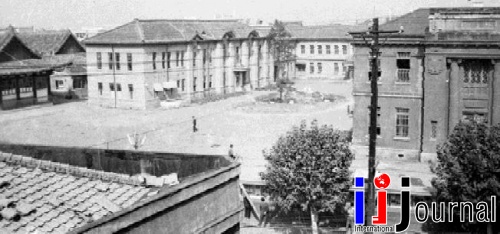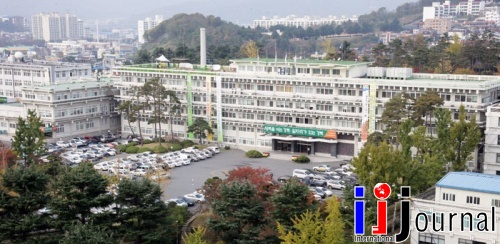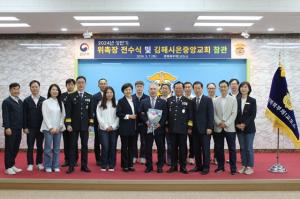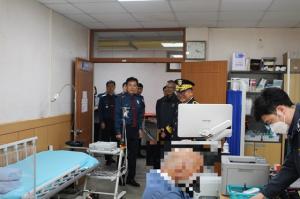700th Anniversary Gyeongsangbuk-do, History of Relocation
Gyeongsanbuk-do was the territory of Jinhan, one of the Three Han States of ancient Korea. And it was the mainland of Silla, Korea's golden kingdom which unified three kingdoms and had 1000 years of rule and splendid culture. 'Gyeongsang-do' was first named in 1314, during the Goryeo Dynasty. During the Joseon Dynasty, provincial governors resided in 'Gamyeong'. There were 8 Gamyeong throughout the Joseon. Among them, the Gyeongsang-Gamyeong had been situated in Sangju and was moved to Daegu in 1601. In 1896, the local administration system had 13 areas and the region was called as 'Gyeongsangbuk-do'. A governor was dispatched to Daegu and he had control over 41 gun-s(counties).
 |
| ▲ Former Gyeongbuk Government Building in Pojeong-dong, Jung-gu, Daegu ⓒ IIJournal |
The government building of Gyeongsangbuk-do was first built in Pojeong-dong, Jung-gu, Daegu. The building was relocated to Sangyeok-dong, Buk-gu, Daegu in 1966. In 1981 Daegu was raised to the status of a city under the direct control of the central government, and it was seperated from Gyeongsangbuk-do. Thus the government building of Gyeongbuk has been located in Daegu, which was not the area of responsibility. A discussion of relocation took place in 1991 with the revival of the autonomous local government system. It was decided to move the government building to Andong·Yecheon area by 2014.
2014 is a special year for Gyeongbuk, because this year marks the 700 anniversary of its founding. The original plan of Gyeongbuk was to open a new government building in time for the 700th anniverssary. However, the relocation faced difficulties due to the settlement condition for government officials. The Governor of Gyeongbuk, Kim Gwan-Yong declared that the relocation will go as planned, and that he will go to the new government building when the bilding is completed. He showed his will to finish the relocation at the end of the year, by saying that he would commute to and from the new building even though there is no official residence.
Gyeongbuk Government Building, Heralds the New Millenium
Gyeongbuk was the only region where there was a discordance between the location of government building and the administrative area. Until now, the discordance has caused various admin problems. There was contradictions in self-governing administration and service provision. It was difficult to foster the sense of unity among the inhabitants.
 |
| ▲ The government building of Gyeongbuk situated in Sangyeok-dong, Buk-gu, Daegu ⓒ IIJournal |
The present site of the government building came into a Gyeongbuk's possession in 1958. The construction was completed in 1965. The site is well-known as the ideal spot in terms of geometric geography. The site is a good example of the implementation of 'Bae-San-Im-Soo (背山臨水, leaning against mountain and facing waters)'. The government building overlooks the center of city, and faces the Sincheon River. When it comes to the size and arrangement, the building is regarded as a 'chef-d'oeuvre' reflecting its time. And it was the highest building in Daegu at that time. The building was four floors above ground and one underground. Now the concrete building has 6 floors abouve ground.
The government complex is composed of the main building, 7 annexe buildings, police department, police school, fire department, etc. Main organizations and direct management organizations exist together in the site. The government building was relocated in 1966 after the completion. The main building was built at the site where a feldspar sandstone was removed. After two years, the police headqurter was established at the east side of the main building and the annexe No.1 was built at the west side antonomastically. The government building was the most magnificent building in Daegu and it was a symbol of Gyeongsangbuk-do. Bilateral symmetry, balancing method were used to construct the building. Before the relocation, the present government building is preparing new history leaving its half-century history.
The New Cityof the New Provincial Government Building, The Center of Culture, Ecology, Administration
 |
| ▲The new site of the Government buildiThe new site of the Government building of Gyeongbuk is a typical example of 'Bae-San-Im-Soo(背山臨水)'. ⓒIIJournal |
The new site of the Government building of Gyeongbuk is a typical example of 'Bae-San-Im-Soo(背山臨水)'. The two rivers, Naeseongcheon River and Nakdonggang River flow facing each other. And the two veins of the mountains, Munsu Jimaek vein and Bohyeon Jimaek vein face each other too. So the site leans against the mountains and overlooks the rivers. The new building is designed to have 7 floors above the ground and 2 undergrounds over the 143-thousand㎡ of total area. The complex is composed of the main building, the new building of provincial assembly, multipurpose theater, residential welfare center etc. All buildings are roofed with Korean traditional tiles, so the exterior of the building fits for the identity of Gyeongbuk, 'The window to the spirit of Korea'.
 |
| ▲The three theme of the city : 'Culture city of living history and tradition', 'Rural ecological city leading the low-carbon green growth', 'Knowledge industry and administrative city ⓒ IIJournal |
The new city that will host the new provincial government building (Andong-Yecheon) is being constructed under the three themes of 'Culture city of living history and tradition', 'Rural ecological city leading the low-carbon green growth', 'Knowledge industry and administrative city leading the new growth'.
Andong and Yecheon have traditionally been a root of academic and traditional culture of Korea. So this region is suitable for the traditional culture town. Also, the new town will be constructed as an ecological city which introduces renewable energy system, green traffic system and as a water-circulating waterfront city. The new town will not only provide the core function but also offer the construction of high-tech industry cluster and convention service, financial service and business service. It will serve both educational and cultural role by establishing autonomous public high school and differentiated university, and by constructing theme park, museum, theater, exhibition hall etc.
Also the new town will function as a transport center which links the four cardinal directions. The new town is conveniently located and has convenient access to the central inland expressway, central expressway. Also with the upcoming construction of expressways, the accessibility will be improved. The relocation of the provincial government building is expected to solve development imbalance and the economic activation of the nothern parts of Gyeongbuk region which have been behind.
개도 700년 경상북도, 도청 이전의 역사
[국제i저널 = 경북 여의봉, 최웅비 기자] 경상북도는 기원전 삼한의 하나인 진한이 자리 잡은 곳이며, 삼국을 통일하여 천년 왕조와 찬란한 문화를 꽃피웠던 신라의 본토였다. 경상도라는 명칭은 고려 충숙왕 원년인 1314년에 처음 생겨났다. 한편, 조선시대 각 도의 관찰사가 거처하던 관청인 감영은 전국에 모두 8곳이 있었다. 그 중 경상도의 감영은 상주에 있던 것이 1601년에 대구로 옮겨졌다. 그 이후 조선 고종 33년인 1896년에는 13도제가 실시되며 경상북도라 칭하고 대구에 관찰사를 두어 41군을 관할했다.
▲ 대구 중구 포정동(현 경상감영공원 부지) 에 건립되었던 경북도 청사 ⓒ 국제i저널
경상북도 청사는 조선조 경상감영의 소재지인 대구 중구 포정동에 설치됐다. 1966년에는 경북 도청이 대구 북구 산격동으로 이전했다. 그러나 1981년에 대구시가 직할시로 승격되며 경상북도와 분리되었고 도청이 행정담당구역이 아닌 지역에 위치하는 상황이 이어졌다. 1991년 지방자치제가 부활하면서 도청 이전에 대한 논의가 이루어졌고, 2008년 경북도청을 2014년까지 안동·예천지역으로 이전한다는 결정이 내려졌다.
2014년은 경북이 개도 700주년을 맞이하는 해로서 특별한 의미를 갖는 해이다. 도의 당초 계획은 개도 700주년에 맞추어 신청사를 개청하는 것이었으나 직원들의 정주 여건 문제로 도청 이전이 난항을 겪기도 했다. 이에 대해 김관용 경북도지사는 도청 이전을 계획대로 진행하여 연말에 신도청 청사가 완공되면 신청사로 출근하려는 뜻을 밝힌 바 있다. 김 지사는 따로 관사가 없는 상황이라도 거처를 마련해 직접 출퇴근할 것이라며 연말 도청 이전 에 대한 확고한 의지를 보였다.
경북도청 산격동 청사, 반세기 역사 뒤로하고 새천년 맞이
경북은 자치단체 중 유일하게 행정관할 구역과 도청의 위치가 불일치하던 지역이었다. 지금까지 도정의 중심인 도청이 대구에 소재함으로써 여러가지 행정적 문제가 있었다. 우선, 관할 구역과 다른 도청의 입지로 자치행정과 서비스 제공에 모순이 발생했으며 도민의 일체감을 조성하는 데 있어서도 어려움이 있었다.
 |
현재 대구 북구 산격동의 경북도청 부지는 1958년에 경북도 소유가 되었고, 1965년 청사가 준공되었다. 부지는 경북도청이 옮겨갈 이전지와 마찬가지로 배산임수의 전형으로 유명하다. 시내를 한눈에 바라볼 수 있는 곳에 위치하여 앞으로는 신천이 흐르고 있는 곳이다. 청사 건물은 건축 규모와 배치에 있어 당시 시대 상황에 맞는 관공서 건축의 대표작으로 여겨지며 준공 당시 대구에서 가장 높은 건물이었다. 처음에 지하 1층 지상 4층으로 건축된 콘크리트 건물이 현재는 6층으로 증축되었다.
청사는 도본청을 비롯하여 7개의 별관, 경찰청, 경찰학교, 소방본부, 대외통상교류관 등으로 구성되어 있으며 경북도 실과와 산하기관이 위치해 있다. 청사는 1966년에 준공을 거쳐 이전하였는데, 장석사암(일명 청석)을 깨고 빼낸 자리에 본청을 건립했고, 2년 후 본청의 동편의 경창청(경찰국) 청사와 서편의 별관1(의사당) 건물을 대칭으로 지었다. 경상북도 청사는 80년대 초까지 대구 시내에서 가장 웅장한 자태를 뽐냈으며, 전후·좌우 대칭, 균형 기법 등이 동원된 경북의 상징물이었다. 도청 이전을 맞이하여 산격동 청사는 반세기에 가까운 역사를 뒤로하고 새로운 역사를 준비하고 있다.
경북도청 이전 신도시, 문화, 생태, 행정 중심지
 |
안동·예천 소재의 도청 이전지는 풍수적 입지조건에 있어 전형적인 배산임수지역이다. 안동시 풍천면 갈전리 일대는 두 하천인 내성천과 낙동강과 백두대간의 두 지맥인 문수지맥과 보현지맥이 남북으로 마주보며 지형을 형성하고 있는 곳이다. 이러한 명당에 건설 중인 신청사는 갈전리 일대에 부지 24만5천㎡, 연면적 14만3천㎡에 지상 7층, 지하 2층의 규모로 설계되었다. 건물은 본청 및 도의회 신청사, 다목적공연장, 주민복지관 등 총 4개동으로 건립된다. 특히 모든 건물의 지붕이 전통 기와로 구성되어 경북의 정체성으로 선정된 ‘한국 정신의 창’에 걸맞는 외관을 가지게 된다.
 |
안동시 풍천면과 예천군 호명면 일원에 조성 중인 경북도청이전 신도시는 ‘역사와 전통이 살아있는 문화도시’, ‘저탄소 녹색성장을 주도하는 전원형 생태도시’, ‘새로운 성장을 이끌어가는 지식산업 행정도시’라는 세 가지 테마에 맞춰 조성되고 있다.
안동·예천 지역은 전통적으로 학문과 전통 문화의 뿌리가 깊은 곳으로 역사와 전통을 살린 문화도시에 적합한 지역이다. 또한 신재생에너지시스템을 도입하고, 녹색교통시스템을 구축하며 물순환형 수변도시로 조성하여 생태도시로 조성된다. 한편, 신도시는 핵심기능 외에도 산·학연 첨단 산업클러스터 조성과 컨벤션, 금융, 비즈니스 서비스를 제공하여 연구개발 및 비즈니스 거점도시로 탄생할 예정이다. 또한 교육 문화 부문에서도 자율형 공립고, 특성화 대학을 유치하고, 테마파크, 미술관, 공연장, 전시장 등을 설치해 교육 및 문화기능을 창출할 것이다.
또한 신도시는 동서남북을 연결하는 중심지로 기능할 수 있다. 신도시는 중부내륙·중앙고속도로와 인접하며 향후 동서4축·5축과 세종시 연결 고속도로를 통해 광역적 접근이 양호한 곳에 위치한다. 경북의 지리적 중심지로 도청이 이전함으로써 과거 구미~대구~포항의 산업벨트를 따라 집중되었던 개발을 벗어나 상대적으로 낙후된 경북 북부지역에 인구가 유입되고 경제 활성화 및 균형개발을 기대할 수 있게 되었다.
취재 : 여의봉, 최웅비 yeu3030@naver.com
<저작권자 © 국제i저널, 무단 전재 및 재배포 금지>

 상주교육지원청 오늘은 어린이날 행복하 - 데이~~
상주교육지원청 오늘은 어린이날 행복하 - 데이~~




